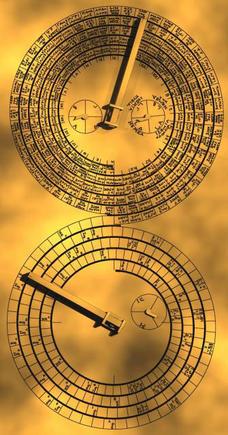Antikythera mechanism
Antikythera mechanism
The Antikythera mechanism is an ancient Greek analog computer and orrery used to predict astronomical positions and eclipses for calendar and astrological purposes decades in advance. It was discovered in 1901 in the Antikythera shipwreck off the coast of the Greek island Antikythera, between Kythera and Crete. The device, housed in a wooden frame, is dated to have been created around the late second century BC.
Description[edit | edit source]
The Antikythera mechanism is composed of at least 30 meshing bronze gears. The largest gear, often referred to as the main gear, is approximately 140 millimeters in diameter and has 223 teeth. The device is operated by turning a hand-crank, which in turn moves the gears and simulates the motion of the Sun, Moon, and possibly the planets.
Functionality[edit | edit source]
The mechanism is believed to have been used to predict solar eclipses and lunar eclipses based on the Saros cycle. It also tracked the Metonic cycle, a period of 19 years after which the phases of the moon repeat on the same days of the year. Additionally, it could have been used to track the Olympiad cycle, the four-year period between the Olympic Games.
Discovery and Analysis[edit | edit source]
The Antikythera mechanism was discovered in 1901 by sponge divers off the coast of Antikythera. It was found among the remains of a shipwreck that dates back to the first century BC. The device was heavily corroded and fragmented, but subsequent analysis using X-ray and CT scanning has revealed much about its internal structure and function.
Significance[edit | edit source]
The Antikythera mechanism is considered one of the most significant technological artifacts from the ancient world. It demonstrates the advanced understanding of astronomy and mechanical engineering possessed by the ancient Greeks. The complexity of the device was not matched until the development of astronomical clocks in medieval Europe.
Related Pages[edit | edit source]
- Analog computer
- Orrery
- Astronomical clock
- Ancient Greek technology
- Antikythera shipwreck
- Saros cycle
- Metonic cycle
- Olympiad cycle
Categories[edit | edit source]
This article is a ancient Greece–related stub. You can help WikiMD by expanding it!
Search WikiMD
Ad.Tired of being Overweight? Try W8MD's physician weight loss program.
Semaglutide (Ozempic / Wegovy and Tirzepatide (Mounjaro / Zepbound) available.
Advertise on WikiMD
|
WikiMD's Wellness Encyclopedia |
| Let Food Be Thy Medicine Medicine Thy Food - Hippocrates |
Translate this page: - East Asian
中文,
日本,
한국어,
South Asian
हिन्दी,
தமிழ்,
తెలుగు,
Urdu,
ಕನ್ನಡ,
Southeast Asian
Indonesian,
Vietnamese,
Thai,
မြန်မာဘာသာ,
বাংলা
European
español,
Deutsch,
français,
Greek,
português do Brasil,
polski,
română,
русский,
Nederlands,
norsk,
svenska,
suomi,
Italian
Middle Eastern & African
عربى,
Turkish,
Persian,
Hebrew,
Afrikaans,
isiZulu,
Kiswahili,
Other
Bulgarian,
Hungarian,
Czech,
Swedish,
മലയാളം,
मराठी,
ਪੰਜਾਬੀ,
ગુજરાતી,
Portuguese,
Ukrainian
Medical Disclaimer: WikiMD is not a substitute for professional medical advice. The information on WikiMD is provided as an information resource only, may be incorrect, outdated or misleading, and is not to be used or relied on for any diagnostic or treatment purposes. Please consult your health care provider before making any healthcare decisions or for guidance about a specific medical condition. WikiMD expressly disclaims responsibility, and shall have no liability, for any damages, loss, injury, or liability whatsoever suffered as a result of your reliance on the information contained in this site. By visiting this site you agree to the foregoing terms and conditions, which may from time to time be changed or supplemented by WikiMD. If you do not agree to the foregoing terms and conditions, you should not enter or use this site. See full disclaimer.
Credits:Most images are courtesy of Wikimedia commons, and templates, categories Wikipedia, licensed under CC BY SA or similar.
Contributors: Prab R. Tumpati, MD







